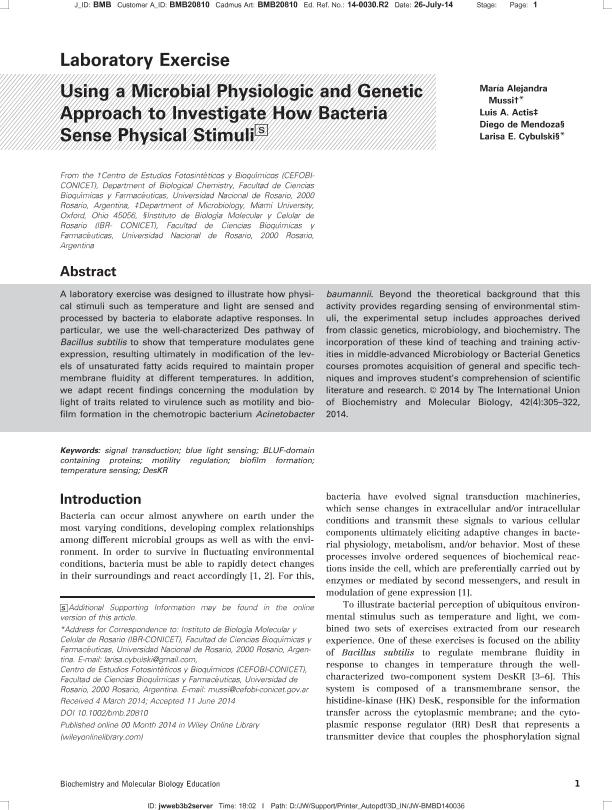Mostrar el registro sencillo del ítem
dc.contributor.author
Mussi, María Alejandra

dc.contributor.author
Actis, Luis A.
dc.contributor.author
de Mendoza, Diego

dc.contributor.author
Cybulski, Larisa Estefania

dc.date.available
2016-03-17T18:05:56Z
dc.date.issued
2014-04
dc.identifier.citation
Mussi, María Alejandra; Actis, Luis A.; de Mendoza, Diego; Cybulski, Larisa Estefania; Using a microbial physiologic and genetic approach to investigate how bacteria sense physical stimuli; Wiley; Biochemistry and Molecular Biology Education; 42; 5; 4-2014; 427-434
dc.identifier.issn
1470-8175
dc.identifier.uri
http://hdl.handle.net/11336/4834
dc.description.abstract
A laboratory exercise was designed to illustrate how physical stimuli such as temperature and light are sensed and processed by bacteria to elaborate adaptive responses. In particular, we use the well-characterized Des pathway of Bacillus subtilis to show that temperature modulates gene expression, resulting ultimately in modification of the levels of unsaturated fatty acids required to maintain proper membrane fluidity at different temperatures. In addition, we adapt recent findings concerning the modulation by light of traits related to virulence such as motility and biofilm formation in the chemotropic bacterium Acinetobacter baumannii. Beyond the theoretical background that this activity provides regarding sensing of environmental stimuli, the experimental setup includes approaches derived from classic genetics, microbiology, and biochemistry. The incorporation of these kind of teaching and training activities in middle-advanced Microbiology or Bacterial Genetics courses promotes acquisition of general and specific techniques and improves student?s comprehension of scientific literature and research.
dc.format
application/pdf
dc.language.iso
eng
dc.publisher
Wiley

dc.rights
info:eu-repo/semantics/openAccess
dc.rights.uri
https://creativecommons.org/licenses/by-nc-sa/2.5/ar/
dc.subject
Microbial
dc.subject
Genetic
dc.subject.classification
Bioquímica y Biología Molecular

dc.subject.classification
Ciencias Biológicas

dc.subject.classification
CIENCIAS NATURALES Y EXACTAS

dc.title
Using a microbial physiologic and genetic approach to investigate how bacteria sense physical stimuli
dc.type
info:eu-repo/semantics/article
dc.type
info:ar-repo/semantics/artículo
dc.type
info:eu-repo/semantics/publishedVersion
dc.date.updated
2016-03-30 10:35:44.97925-03
dc.journal.volume
42
dc.journal.number
5
dc.journal.pagination
427-434
dc.journal.pais
Estados Unidos

dc.journal.ciudad
Hoboken
dc.description.fil
Fil: Mussi, María Alejandra. Consejo Nacional de Investigaciones Científicas y Técnicas. Centro Científico Tecnológico Rosario. Centro de Estudios Fotosintéticos y Bioquímicos (i); Argentina
dc.description.fil
Fil: Actis, Luis A.. Miami University. Department of Microbiology; Estados Unidos
dc.description.fil
Fil: de Mendoza, Diego. Consejo Nacional de Investigaciones Científicas y Técnicas. Centro Científico Tecnológico Rosario. Instituto de Biología Molecular y Celular de Rosario; Argentina
dc.description.fil
Fil: Cybulski, Larisa Estefania. Consejo Nacional de Investigaciones Científicas y Técnicas. Centro Científico Tecnológico Rosario. Instituto de Biología Molecular y Celular de Rosario; Argentina
dc.journal.title
Biochemistry and Molecular Biology Education

dc.relation.alternativeid
info:eu-repo/semantics/altIdentifier/url/http://onlinelibrary.wiley.com/doi/10.1002/bmb.20810/abstract
dc.relation.alternativeid
info:eu-repo/semantics/altIdentifier/doi/http://dx.doi.org/10.1002/bmb.20810
dc.relation.alternativeid
info:eu-repo/semantics/altIdentifier/doi/10.1002/bmb.20810
dc.relation.alternativeid
info:eu-repo/semantics/altIdentifier/pmid/25052184
Archivos asociados
